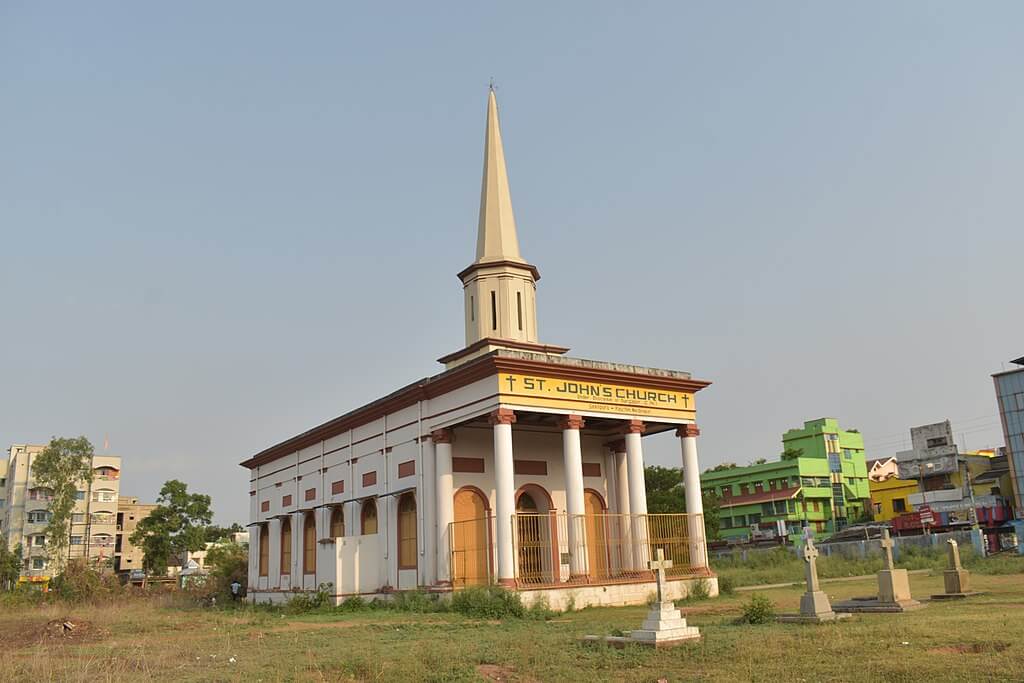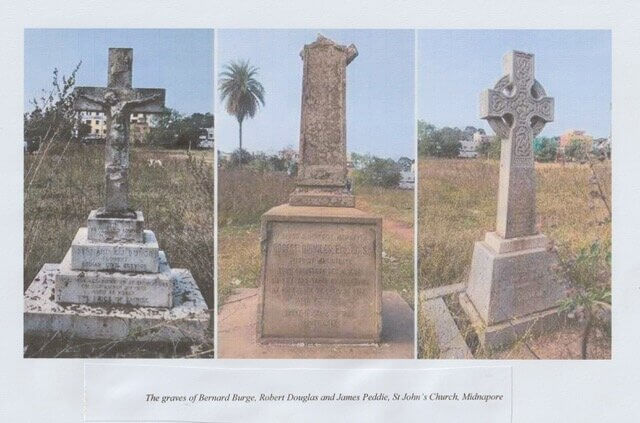THE MIDNAPORE MURDERS
(This article by Dr Rosie Llewellyn-Jones first appeared in the Autumn 2023 issue of Chowkidar, Volume 16, Number 6)

During the troubled period of the 1930s, when calls for Indian independence grew stronger, three British officers were gunned down within eighteen months of each other in the Bengali town of Midnapore. Their stories are related in a well-researched article published in the Kolkata Telegraph together with photographs of the three graves at St John’s church. Sadly the graveyard is utterly neglected today, rat-infested and subject to vandalism and overgrown vegetation. The Telegraph’s focus was on the young Bengali men who carried out the assassinations while BACSA’s interest is in the history of these three men, James Peddie, Robert Douglas and Bernard Burge. The post of District Magistrate in Midnapore had been a fairly uncontroversial one until the Hijli Detention Camp was established there in 1930. This housed men who were being held for offences against the British government which was cracking down hard on the armed struggle for independence.
James Peddie was a 38-year old Scotsman, born in Fife, who had served in the Great War. He joined the ICS in 1921, and a decade later was appointed magistrate at Midnapore. His short tenure there was marked by arrests and raids on the townspeople and ‘oppressive measures’, including public floggings. An underground organisation, Bengal Volunteers, planned to kill him and he was shot down inside Midnapore School, while visiting an exhibition one evening. The old-established school had no electricity and the room was dimly lit by kerosene lamps. Peddie died the following day, 8 April 1931, in hospital. His grave is marked by a handsome stone cross and the inscription bears the words ‘Carry On’.
Peddie’s successor was another Scotsman, Edinburgh-born Robert Douglas, known as a good cricketer. It was during his tenure that one incident in particular sparked a deep resentment in local people. This was the shooting of two unarmed detainees in the Hijli Camp. Douglas blamed the prisoners and this caused an outcry in Bengal, with Rabindranath Tagore writing a strong letter to The Statesman, which the British editor refused to publish. Douglas had increased his own security and began to work from home, only visiting the District Board office for monthly meetings. But it was here on 30 April 1932 that he was shot by two young Bengalis who got in through a rear entrance. He died immediately and one of his assassins was hanged at Midnapore Central Jail the following year. Douglas was buried alongside Peddie under another stone cross (recently vandalised) and his inscription concludes ‘There is peace to thee and no hurt’.
Not surprisingly it became increasingly difficult to fill the office at Midnapore. Two British District Magistrates killed within thirteen months was not an inviting prospect. Against the wishes of his wife, Bernard Burge accepted the post. Like Peddie, Burge had served in the Great War, for which he was decorated and he subsequently served on the North West Frontier during the Third Afghan War. Leaving the Army, he joined the ICS in 1921. Like Douglas, Burge was a keen cricketer, having captained the Ballyganj Cricket Club in Calcutta. He had also, briefly, been in command of the Hilji Detention Camp after the shooting incident, which made him a strong target for the Bengal Volunteers. His bungalow was patrolled by sentries night and day and his own bodyguards accompanied him everywhere. His wife, Barbara, was punctilious in vetting anyone who wanted to meet her husband, interviewing everyone beforehand and accompanying the visitors to see her husband. Perhaps surprisingly she herself was not a target and so was able to travel freely around Midnapore.
Football has a particularly strong following in Bengal, both in the past and today. As an avid football fan, and president of the Town Football Club, Burge decided to watch a match at the Midnapore ground against the Mohammedan Sporting Club on 2 September 1933. It was reported that Burge and his security team felt no harm could come to him on a football field. This was a dreadful mistake. Getting out of his car, Burge is said to have changed into a football jersey and as he walked towards the pitch he was gunned down by five assassins. His police security officers retaliated and two of the killers were shot dead – the remaining three being captured by the football crowd and subsequently hanged.
Burge joined his two predecessors in St John’s graveyard. A marble cross with an image of Jesus crucified marks his tomb. His inscription concludes with the words ‘The Price of Empire’ – an overtly political statement and certainly not a religious sentiment. There was huge outrage over Burge’s murder, from the Viceroy to the Secretary of State for India and the Governor of Bengal. It was pointed out that Burge was not a soldier in a country at war but ‘a civil official performing just his daily round, the common task with the shadow of death as a constant companion, simply because he was doing his job’. His widow, Barbara who had done all she could to ensure his safety was awarded the Kaiser-i-Hind medal. Burge’s war medals were auctioned recently at Spink, fetching a total of £1,800. No further British officials seem to have been appointed to the Midnapore post and the three graves at St John’s are a poignant reminder of men working in the closing years of Empire with fatal consequences.

